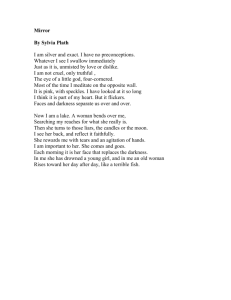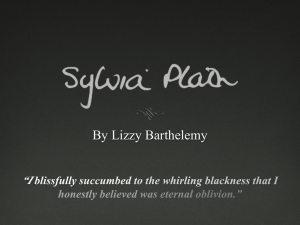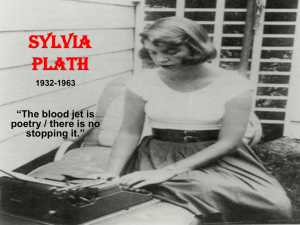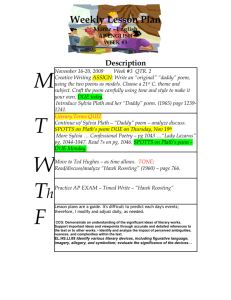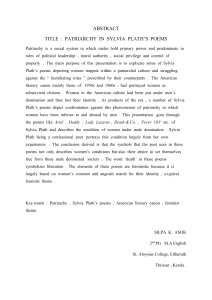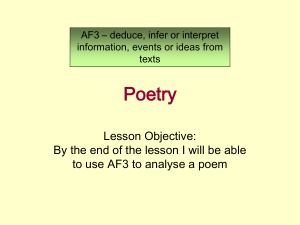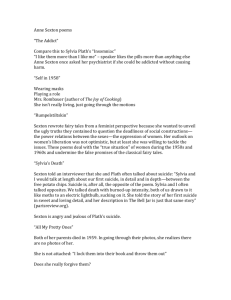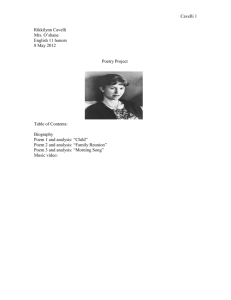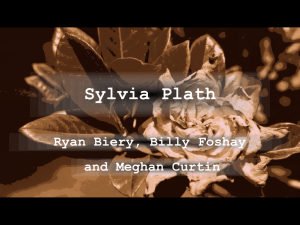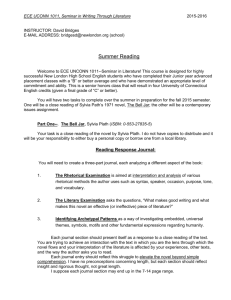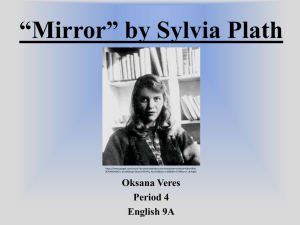Sylvia Plath EXPOSED
advertisement
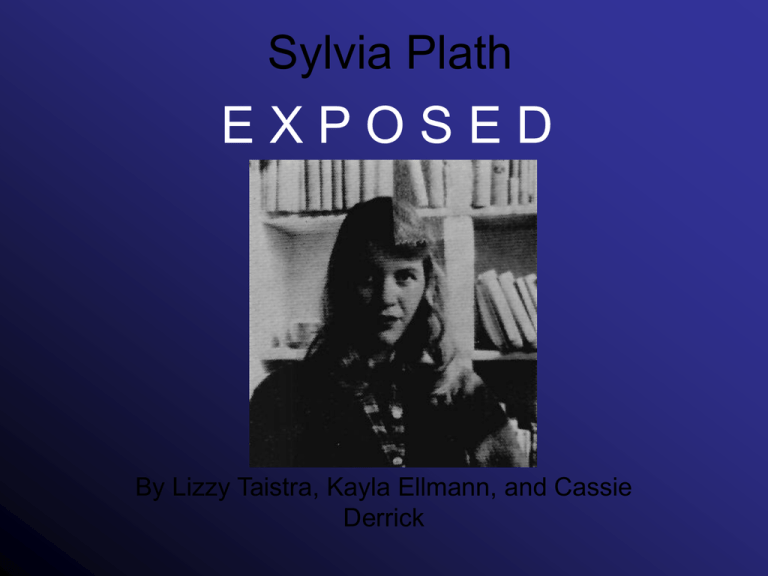
Sylvia Plath EXPOSED By Lizzy Taistra, Kayla Ellmann, and Cassie Derrick Background • • • • • • • • Born in 1932 in Massachusetts Published first poem at age 8 Always a star student Scholarship to Smith College Suffered from Bipolar Disorder Attempted suicide Married to Ted Hughes in 1956 Two children-Frieda and Nicholas • Successful Suicide in 1963; age 30 Sylvia and her two children Frieda and Nicholas Similarities Between Life and Poetry • • • • • • • • • • Ted and Sylvia on their honeymoon Father’s death- “Daddy” Parents’ backgrounds (German and Austrian decent Attempted suicide in college Dad was an expert on bees- “The Bee Keepers Daughter” Attempted suicide- book The Bell Jar Miscarriage- “Childless Woman” Struggled Marriage Ariel- inspired by her horse Ariel and her love for the sea Struggled financially and sick children 1962-Towards the end of her life she wrote her best and most emotional and recognized poetry Plath's Patterns • -Inconsistent end rhyming - Analyzes different situations in life by viewpoints of different people, sometimes even by material objects/ideas (personification) (ex: "Mushrooms": "our toes, our noses take hold on the loam acquire the air") -Situations in each poem are over a long period of time (ex: Mirror) and the viewpoint changes throughout -Uses a lot of colors to describe feelings and certain situations. She changes them as the feelings begin to change. -Also uses color to set the mood (ex: black for darkness) -Often uses dark or even harsh descriptions of heavy feelings -has an obsession with death -Her poetry is like looking into a magnified glass; she sees every detail as it is and examines it closely and carefully ("Tulips":" the tulips are too red", "Mushrooms": she examines mushrooms which someone would normally never look at because they are such simple creatures; which she gives such powerful and outspoken personalities) -Picks objects that no one would think of (RANDOM OBJECTS) and describes them as if they were common (?). (Random objects and beings that we don't notice often.) -Seems to go off on tangents. (Off task) Themes and Motifs • • • • • • Love Hate Death, Hospitals Family Surroundings Marriage Literary Criticism • • • • • • Dark and negative Tangents Confessional Limitless Impressive imagery Language “Dying is an art, like everything else. I do it exceptionally well. I do it so it feels like hell. I do it so it feels real. I guess you could say I've a call. “ - Sylvia Plath Literary Criticism • Eleanor Ross Taylor: “Self-consciously womanly, yet there is a curious underlying rejection of being a woman.” • Thomas Blackburn: “Her imagery tends to get out of hand…” “ becomes not a single experience but a series of intriguing ‘literary gems’.” • Robert Lowell: “Language never dies in her mouth.” • William F. Claire: “Glorious, mostly sick, unbelievably irritating.” Reflection of Criticism • After reading many of her poems we agree with what the critics have said much of her writing is dark and depressing, but after learning about her life we can understand why they think that. We strongly agree with William F. Clare’s vision on how," A rare random descent was to strike Sylvia Plath often in poems that were fastidious in their choice of words, perceptive in their handling of metaphor and simile. The wonder of it all was her ability to keep imagery working for the poem and not against it. Her poems resist line extractions, build steadily, word by word, image by image." Reflection • Although many may have thought of Sylvia Plath to be insane she was just simply misunderstood. For Plath, writing was an outlet to express her deepest emotions. • “And by the way, everything in life is writable about if you have the outgoing guts to do it, and the imagination to improvise. The worst enemy to creativity is self-doubt.” – Sylvia Plath
